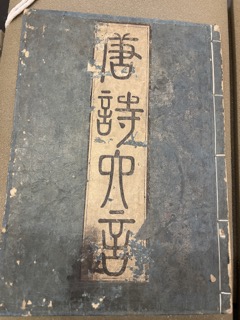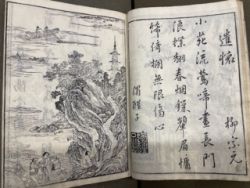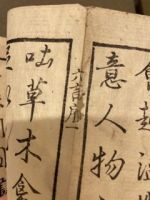The Illustrated Tang Poems: Difference between revisions
No edit summary |
No edit summary |
||
| Line 6: | Line 6: | ||
== Substrates == | == Substrates == | ||
[[File:Tang poem | [[File:Tang poem paper.jpeg|250px|thumb|"Xuan paper"]] | ||
=== Printing, Paper & Cover === | === Printing, Paper & Cover === | ||
The book was printed with woodblock printing, and the paper used as the leaves are “xuan paper”. The cover of the book is a stronger type of paper dyed dark blue backed by another xuan paper, which gave it more strength. The xuan paper has a soft texture and is semi-transparent. This gives the readers a unique experience of being able to see through the illustrations to look at the poems as the two are printed on the same sheet. | The book was printed with woodblock printing, and the paper used as the leaves are “xuan paper”. The cover of the book is a stronger type of paper dyed dark blue backed by another xuan paper, which gave it more strength. The xuan paper has a soft texture and is semi-transparent. This gives the readers a unique experience of being able to see through the illustrations to look at the poems as the two are printed on the same sheet. | ||
| Line 13: | Line 13: | ||
The book was bound with the “butterfly binding” method. Two pages are printed on the same sheet, which is then folded inwards. These sheets of paper are then bound to form a book. For this book, in particular, we have one page of the illustration and one page of the poem printed on the same sheet. Since these are folded, readers have to flip to look at the poem for each illustration. This is an interesting tradeoff made at the substrate level – by prioritizing the ease of printing, the readers cannot enjoy looking at the illustration and reading the poem simultaneously. | The book was bound with the “butterfly binding” method. Two pages are printed on the same sheet, which is then folded inwards. These sheets of paper are then bound to form a book. For this book, in particular, we have one page of the illustration and one page of the poem printed on the same sheet. Since these are folded, readers have to flip to look at the poem for each illustration. This is an interesting tradeoff made at the substrate level – by prioritizing the ease of printing, the readers cannot enjoy looking at the illustration and reading the poem simultaneously. | ||
[[File:Tang poem foreedge.jpeg|150px|thumb|Fore-edge]] | |||
=== Fore-edge === | === Fore-edge === | ||
Since each sheet is folded inwards for binding, it gives the book a unique space on the outer edge for each leaf. This became an extra space for printing that is otherwise impossible in other forms of binding. For this book, the fore-edge spaces are used for prologue labeling. For example, it says “Prologue 1” in the picture on the right. | Since each sheet is folded inwards for binding, it gives the book a unique space on the outer edge for each leaf. This became an extra space for printing that is otherwise impossible in other forms of binding. For this book, the fore-edge spaces are used for prologue labeling. For example, it says “Prologue 1” in the picture on the right. | ||
Revision as of 00:08, 4 May 2022

Historial Significance
By looking at how detailed and well-crafted the illustrations in the book are, we can infer that woodblock printing became rather mature in China around the 17th century. Since this is a collection of illustrations for poems, we could also infer that perhaps sharing, reading, and appreciating poems was a rather significant part of people’s lives in the Ming Dynasty, Literature and arts were well-celebrated by the society.
Substrates

Printing, Paper & Cover
The book was printed with woodblock printing, and the paper used as the leaves are “xuan paper”. The cover of the book is a stronger type of paper dyed dark blue backed by another xuan paper, which gave it more strength. The xuan paper has a soft texture and is semi-transparent. This gives the readers a unique experience of being able to see through the illustrations to look at the poems as the two are printed on the same sheet.
Binding
The book was bound with the “butterfly binding” method. Two pages are printed on the same sheet, which is then folded inwards. These sheets of paper are then bound to form a book. For this book, in particular, we have one page of the illustration and one page of the poem printed on the same sheet. Since these are folded, readers have to flip to look at the poem for each illustration. This is an interesting tradeoff made at the substrate level – by prioritizing the ease of printing, the readers cannot enjoy looking at the illustration and reading the poem simultaneously.

Fore-edge
Since each sheet is folded inwards for binding, it gives the book a unique space on the outer edge for each leaf. This became an extra space for printing that is otherwise impossible in other forms of binding. For this book, the fore-edge spaces are used for prologue labeling. For example, it says “Prologue 1” in the picture on the right.